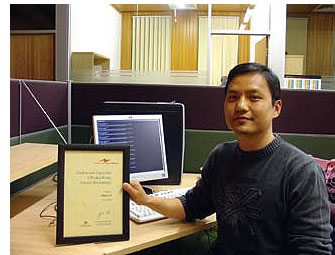

Dr James Jing Cai
The University of Hong Kong, Hong Kong
Exchange to Australian National University, Australia
I was awarded a scholarship under the 2005 Endeavour Australia Cheung Kong Awards for six-months of study at the Australian National University (ˇ§ANUˇ¨). I arrived in Canberra, the capital of Australia, in April 2005. Beautiful autumn colours could be seen on many streets in the inner suburbs of the city. The stunning quietness of Canberra, quite different from dynamic Hong Kong, amazed me immediately, although it should not be strange to me since I had been studying and working in Australia for three years previously.
John Curtin School of Medical Research (ˇ§JCSMRˇ¨), the place I worked at this time, is the Australian national medical research institute. JCSMR was established in 1948 as a result of the vision of Australian Nobel Laureate, Howard Florey, and Prime Minister, John Curtin. Within 50 years, its scientists have made significant discoveries and contributions to world health and won two Nobel Prizes, including the discovery of the role of the major histocompatibility complex for which Peter Doherty and Rolf Zinkernagel shared the 1996 Nobel Prize for Medicine and elucidation of mechanisms of transmission of signals in the nervous system.
My collaborator was Dr Gavin Huttley, the head of the computational genomics laboratory, and who is the leading Australian scientist in molecular evolution and statistical genetics. We share the same research interests including eukaryotic genomics, molecular evolution and bioinformatics. One of the questions we tackled was the context dependency of DNA mutation, i.e., how the mutation rate of a nucleotide is affected by its neighbouring nucleotides. We developed novel probabilistic models for the context-dependent DNA mutation. These models were numerically optimized with algorithms running in parallel on supercomputers within the Australian National Supercomputer Facilities, more precisely revealing the influence of DNA replication and repair on DNA substitution pattern in genomic evolution. Through the collaboration I solved many problems that otherwise would have taken me a very long time to solve by myself. One journal paper based on the findings of our collaborative work is now ready to be submitted. Thanks to the Endeavour Australia Cheung Kong Awards, the now established relationship between the University of Hong Kong and ANU in the area of molecular evolution and bioinformatics will create more win-win situations for both institutions.
 During the six months of study at JCSMR, I also took the chance to join a few other academic activities. In June 2005, I presented my research at the international conference of the Society of Molecular Biology and Evolution (SMBE) in Auckland, New Zealand. In the preceding SMBE conference in Pennsylvania, USA, I was awarded travel support for presenting in the Walter M. Fitch Symposium our significant findings about evolution rate of genes, which were achieved under the guidance of my supervisor, Professor Kwok-Yung Yuen. In July 2005, the Winter School in Mathematical and Computational Biology at Queensland Bioscience Precinct was held by the University of Queensland. One of the workshop sessions was about the application of mathematical software in biology. I happened to have developed a software for bio-sequence data analysis in molecular biology and evolution called MBEToolbox, which was highly relevant to the session. When the organization committee of the workshop knew I was within the audience, they created an extra session for me to introduce the underlying theories and to give a live software demonstration. The topic attracted an audience of hundreds. MBEToolbox is developed in Matlab, a powerful language for scientific and engineering computation. As one of the leading scientists who apply Matlab in biology, I was later on reported by a feature article entitled ˇ§Biology by the Numbersˇ¨ in The Scientist (http://www.the-scientist.com/2005/6/20/32/1).
During the six months of study at JCSMR, I also took the chance to join a few other academic activities. In June 2005, I presented my research at the international conference of the Society of Molecular Biology and Evolution (SMBE) in Auckland, New Zealand. In the preceding SMBE conference in Pennsylvania, USA, I was awarded travel support for presenting in the Walter M. Fitch Symposium our significant findings about evolution rate of genes, which were achieved under the guidance of my supervisor, Professor Kwok-Yung Yuen. In July 2005, the Winter School in Mathematical and Computational Biology at Queensland Bioscience Precinct was held by the University of Queensland. One of the workshop sessions was about the application of mathematical software in biology. I happened to have developed a software for bio-sequence data analysis in molecular biology and evolution called MBEToolbox, which was highly relevant to the session. When the organization committee of the workshop knew I was within the audience, they created an extra session for me to introduce the underlying theories and to give a live software demonstration. The topic attracted an audience of hundreds. MBEToolbox is developed in Matlab, a powerful language for scientific and engineering computation. As one of the leading scientists who apply Matlab in biology, I was later on reported by a feature article entitled ˇ§Biology by the Numbersˇ¨ in The Scientist (http://www.the-scientist.com/2005/6/20/32/1).
All these above let me experience the importance and necessity of academic exchange. I am grateful to the selective committee of the award, and hope more fellow students may benefit from it.
© Copyright 2018 CK Group. All rights reserved.
